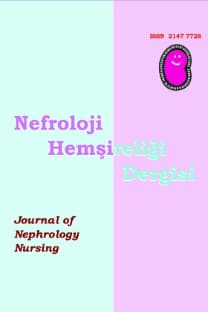Acil Hemodiyaliz Uygulanan Hastalarda Vasküler Erişim Tercihleri: Tek Merkez Deneyimi / Vascular Access Preferences in Patients Undergoing Emergency Hemodialysis: A Single Center Experience
Arteriyovenöz fistül, Hemodiyaliz, Vasküler erişim, Kateterizasyon
Vascular Access Preferences in Patients Undergoing Emergency Hemodialysis: A Single Center Experience
Hemodialysis, vascular access, catheterization, arteriovenous fistula,
___
- 1. Lok CE, Huber TS, Lee T, Shenoy S, Yevzlin AS, Abreo K, Allon M, Asif A, Astor BC, Glickman MH, Graham J, Moist LM, Rajan DK, Roberts C, Vachharajani TJ, Valentini RP; National Kidney Foundation. KDOQI Clinical Practice Guideline for Vascular Access: 2019 Update. Am J Kidney Dis. 2020 Apr;75(4 Suppl 2):S1-S164.
- 2. Allon M. Vascular Access for Hemodialysis Patients: New Data Should Guide Decision Making. Clin J Am Soc Nephrol. 2019 Jun 7;14(6):954-61.
- 3. Hayashi R, Huang E, Nissenson AR. Vascular Access for hemodialysis. Nat Clin Pract Nephrol. 2006;2(9):504-13.
- 4. Woo K, Lok CE. New insights into dialysis vascular access: What is the optimal vascular access type and timing of access creation in CKD and dialysis patients? Clin J Am Soc Nephrol. 2016 ;11(8):1487-94.
- 5. Sequeira A, Naljayan M, Vachharajani TJ. Vascular access guidelines: summary, rationale, and controversies. Tech Vasc Interv Radiol. 2017;20(1):2-8.
- 6. Levey AS, Eckardt KU, Tsukamoto Y, et al. Definition and classification of chronic kidney disease: A position statement from Kidney Disease: Improving Global Outcomes (KDIGO). Kidney Int 2005; 67: 2089-100.
- 7. Süleymanlar G, Utaş C, Arınsoy T, et al. A population based survey of chronic renal disease in Turkey - The CREDIT study. Nephrol Dial Transplant 2011; 26: 1862-71.
- 8. Süleymanlar G, Ateş K, Seyahi N. Türkiye’de Nefroloji, Diyaliz ve Transplantasyon – Registry 2019. Türk Nefroloji Derneği Yayınları, Ankara, 2020. ISBN 978-605–62465–0–0.
- 9. Tordoir J, Canaud B, Haage P, et al: European best practice guidelines on haemodialysis (EBPG) on Vascular Access. Nephrol Dial Transplant 2007; 22 [Suppl 2]:ii88-117.
- 10. Ravani P, Gillespie BW, Quinn RR, et al. Temporal risk profile for infectious and noninfectious complications of hemodialysis access. J Am Soc Nephrol. 2013; 24(10):1668-77.
- 11. Aydın Z, Öztürk S. Gürsu M. Uzun S, Karadağ S, Tayfur F. Çoban T. Kazancıoğlu R. hemodiyaliz hastalarında damar giriş yolu olarak kateter kullanımı: Tek merkez deneyimi. Türk Nefroloji Diyaliz ve Transplantasyon Dergisi 2010;19(1):46-51.
- 12. Al-Balas A, Lee T, Young CJ, Kepes JA, Barker-Finkel J, Allon M. The clinical and economic effect of vascular access selection in patients initiating hemodialysis with a catheter. J Am Soc Nephrol. 2017;28(12):3679-87.
- 13. Rayner HC, Besarab A, Brown WW, Disney A, Saito A, Pisoni RL:Vascular access results from the Dialysis Outcomes and Practice Patterns Study (DOPPS): Performance against Kidney Disease Outcomes Quality Initiative (K/DOQI) clinical practice guidelines. Am J Kidney Dis 2004; 44: 22–6.
- 14. Miguel SS, Chow J. Vascular dialysis Access flow measurement: early intervention through early detection. J Ren Care 2009;35(4):185-91.
- 15. Kelly YP, Mendu ML. Vascular access for renal replacement therapy in acute kidney injury: Are nontunneled catheters the right choice? Semin Dial. 2019;32(5):406-10.
- 16. Coryell L, Lott JP, Stavropoulos SW, et al. The case for primary placement of tunneled hemodialysis catheters in acute kidney injury. J Vasc Interv Radiol. 2009;20(12):1578-81.
- 17. Ozmen S, Kadiroglu AK, Ozmen CA, Danis R, Sit D, Akin D, Yilmaz ME. Does the direction of arterial needle in AV fistula cannulation affect dialysis adequacy? Clin Nephrol. 2008;70(3):229-32.
- 18. Harwood L, Wilson B, Goodman M. Cannulation outcomes of the arteriovenous fistula for hemodialysis: A Scoping review. Nephrol Nurs J. 2017;44(5):411-25.
- 19. Wilson B, Harwood L. Outcomes for successful cannulation of the arteriovenous fistula: perspectives from patients on hemodialysis. Nephrol Nurs J. 2017;44(5):381-8.
- 20. Allon M, Brouwer-Maier DJ, Abreo K, et al. Recommended clinical trial end points for dialysis catheters. Clin J Am Soc Nephrol. 2018;13(3):495-500.
- 21. Almasri J, Alsawas M, Mainou M, et al. Outcomes of vascular access for hemodialysis: A systematic review and meta-analysis. J Vasc Surg. 2016;64(1):236-43.
- 22. Ravani P, Quinn R, Oliver M, et al. Examining the association between hemodialysis access type and mortality: The role of access complications. Clin J Am Soc Nephrol. 2017;12(6):955-64.
- 23. Murea M, Geary RL, Davis RP, Moossavi S. Vascular access for hemodialysis: A perpetual challenge. Semin Dial. 2019;32(6):527-34.
- Yayın Aralığı: Yılda 3 Sayı
- Başlangıç: 2004
- Yayıncı: Türk Nefroloji, Diyaliz ve Transplantasyon Hemşireleri Derneği
Filiz ALTINDAL, Hasan KAYABAŞI, Dede ŞİT, Ezgi ERSOY YEŞİL, Funda YILMAZ, Yağmur KIZILAY, Ayten KARAKOÇ
